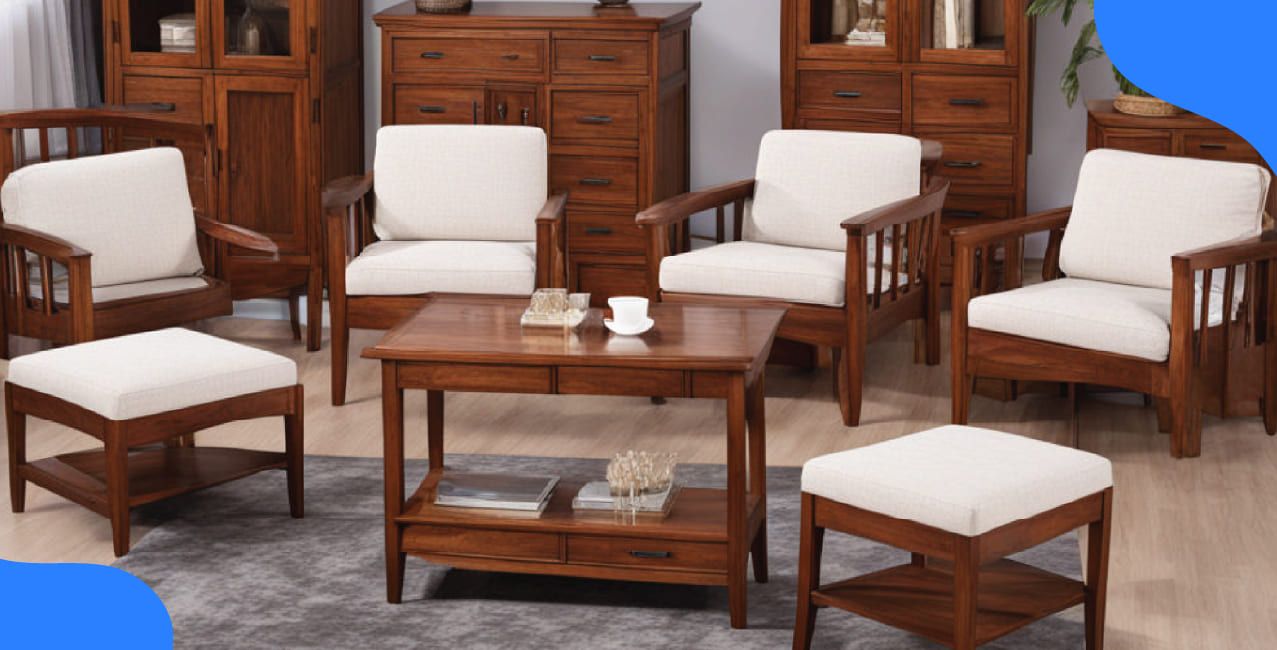
Author
LoansJagat Team
Read Time
6 Min
24 Sep 2025
GST on Wooden Furniture: Complete Guide to Rates & Rules
Key Takeaways
- The 56th GST Council Meeting has impacted the GST rates. This has also impacted the rate of GST on wooden furniture.
- Earlier, you needed to pay 12% GST on furniture of bamboo, rattan and cane, but as per the new rates, you now need to pay only 5% GST on it.
- GST on wooden furniture has various benefits, such as a uniform tax rate, transparency in pricing, easy movement of goods, and a better input tax credit facility.
Goods and Services Tax (GST) is a single tax that applies to the supply of goods and services. Wooden furniture is a commonly purchased household and office item, which falls under this tax structure.
Suppose Nimisha buys a bamboo wardrobe priced at ₹54,000. If she had bought a bamboo wardrobe before September 2025, then she would have to pay additional GST of 12% (₹6,480). However, she had bought it at the end of September 2025, so she needs to pay GST on wooden furniture at 5% (₹2,700).
So, she had to pay a total of ₹56,700 instead of ₹60,480, saving ₹3,780. The revised rate of GST on wooden furniture reduces the final cost of furniture. In this blog, we will explore more about GST on wooden furniture, its benefits, and input tax credit on wooden furniture.
GST On Wooden Furniture
You might know that the 56th GST Council Meeting has made various changes in the GST, including applicable rates on products and services, GST slab rates, and many more. Council has increased GST charges on some products and reduced them on others. Also, some remained unchanged.
GST on wooden furniture such as beds, sofas, tables, and wardrobes is 18%. However, sustainable options like bamboo, cane, and rattan furniture enjoy a lower tax rate of 5%, revised from the earlier 12%. The following table highlights the GST on wooden furniture:
The above-mentioned table shows that eco-friendly furniture is more affordable, while GST on wooden furniture remains costlier due to the higher rate.
For example, if you buy a dining table set that costs ₹50,000, GST at 18% adds ₹9,000, which brings the total to ₹59,000.
On the other hand, if the same dining table set were made from bamboo, GST at 5% would add only ₹2,500, which makes the final price ₹52,500. This shows how GST rates vary depending on the material used.
Read More - GST on Furniture – Complete Guide to Rates & Tax Impact
Bonus Tip: Do you know that the press note is released on 4th September 2025, but new rates and exemptions will take effect from 22nd September 2025.
Benefits Of GST On Wooden Furniture
GST has not only streamlined taxation but also improved transparency and accountability in the furniture sector. The following table highlights the benefits of GST on wooden furniture:
From the above-mentioned table, you can see how GST on wooden furniture has simplified taxation, improved billing, and supported businesses with credit benefits.
Compliance Challenges Faced By Furniture Manufacturers Under GST
GST has simplified taxation; however, many furniture manufacturers still face difficulties in meeting compliance requirements. The following table shows the common compliance challenges faced by furniture manufacturers under GST:
The above-mentioned table shows how compliance responsibilities can affect both small workshops and large manufacturers. If you understand these challenges, then you can plan effectively, use digital tools for record-keeping, and avoid penalties by timely filing.
Input Tax Credit (ITC) On Wooden Furniture
One of the most important advantages of GST is the Input Tax Credit (ITC). Whenever a business, such as a hotel, office, or restaurant, buys wooden furniture, the GST paid on that purchase can be claimed back at the time of filing returns.
This makes furniture purchases more affordable because the tax paid is not lost but adjusted against the GST collected from customers.
Suppose a corporate office spends ₹2,00,000 on bamboo desks for a cafeteria; now they have to pay GST on wooden furniture at 5% (₹10,000). Later, when the corporate office files its GST return, it can claim back ₹10,000 as ITC, which reduces its overall tax liability.
This process directly reduces expenses for businesses. Instead of bearing the entire tax cost, they recover it through ITC.
Bonus Tip: Do you know that in the 56th GST Council Meeting, the Council has also removed two GST slabs, 12% and 18%, leaving 5% and 18% as key GST slabs.
Learn More - Indian’s Can’t Afford Home Renovations, Cars, Basic Furniture; Need Consumer Loans For Everything
Impact Of GST On Furniture On Buyers And Sellers
GST has made pricing clearer for buyers, as bills now show the exact tax amount. For example, a sofa priced at ₹40,000 attracts 18% GST of ₹7,200, making the final cost ₹47,200. Buyers can also compare costs with bamboo furniture taxed at only 5%.
For sellers, GST ensures uniform rates across regions, which reduces confusion. However, small manufacturers face challenges in filing returns and paying GST upfront before receiving full payments, which affects their cash flow.
Conclusion
GST on wooden furniture has brought clarity and uniformity to taxation. Buyers easily understand what they pay, with an 18% rate on most wooden products and a reduced 5% rate on bamboo, cane, and rattan furniture.
GST on wooden furniture has simplified compliance, ensured fair pricing across regions, and supported eco-friendly choices. Also, business benefits through Input Tax Credit, which reduces their effective expenses.
GST has some compliance challenges, but it still continues to streamline trade, promote accountability, and strengthen the furniture market for both manufacturers and consumers alike.
FAQs
1. What is the HSN code for wooden articles of furniture not falling in Chapter 94?
The HSN code for Wooden articles of furniture not falling in Chapter 94 is 4420.
2. What is the HSN code for handicraft: furniture of bamboo, rattan and cane?
The HSN code for Handicraft: Furniture of bamboo, rattan and cane is 940150.
3. What is the new GST rate on granite blocks?
The new GST rate on granite blocks is 5%.
4. What is the new GST rate on bamboo flooring?
The new GST rate on bamboo flooring is 5%.
5. What is the HSN code for furniture wholly made of bamboo, cane or rattan?
The HSN code for Furniture wholly made of bamboo, cane or rattan is 9403.
6. What is the HSN code for other furniture (other than furniture wholly made of bamboo, cane or rattan) and parts thereof?
The HSN code for other furniture (other than furniture wholly made of bamboo, cane or rattan) and parts thereof is 9403.
7. Why is bamboo furniture taxed at a lower GST rate?
Bamboo furniture is taxed at 5% GST as it is eco-friendly, supports rural artisans, and encourages sustainable production.
About the Author

LoansJagat Team
‘Simplify Finance for Everyone.’ This is the common goal of our team, as we try to explain any topic with relatable examples. From personal to business finance, managing EMIs to becoming debt-free, we do extensive research on each and every parameter, so you don’t have to. Scroll up and have a look at what 15+ years of experience in the BFSI sector looks like.

Quick Apply Loan
Subscribe Now


